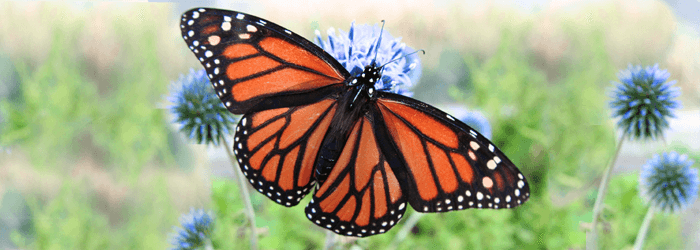We talk a lot about keeping “bugs” out of home and yard – like ants, termites, scorpions and black widow spiders. But some bugs are beneficial guests, like butterflies, moths, safer types of bees, beetles, lady-bugs, and praying mantises. Some are good pollinators for a yard and some will devour destructive pests. The entomologists even say some flies can pollinate your yard.
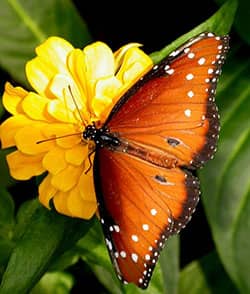
We received advice particularly about the “good bugs,” the pollinators, from experts on Arizona bugs. We spoke with Shaku Nair of the University of Arizona’s Pest Management Center, and Dawn Gouge, professor of entomology at the university. The Arizona Cooperative Extension web site is also a great resource that can provide even more details for homeowners.
Go easy on pesticides in the yard.
According to Dr. Nair, many pesticides, including the “organic” kind, can harm the safe pollinators we want in our yards as well as the bad bugs. Nair suggests it may work to manage many pests by putting on gloves and removing them by hand. That could be impractical. So, if pesticides still seem necessary, choose the least toxic type and apply it in a yard during the evening when pollinators are not around.
Get help from natural predators, like praying mantises & lady-bugs.
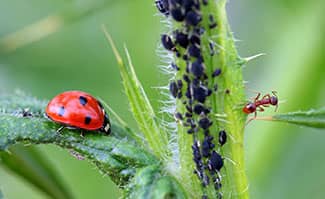
Some Rosie on the House staff members have bought boxes of praying mantises and lady-bugs at nurseries to set free in their yards. Spring is a great season to try this. These beneficial bugs are available at local nurseries and can even be ordered online.
A box of lady-bug eggs, $8 to $10 at one local nursery, for example, can provide thousands of bugs to sprinkle on rose bushes and those bugs will make a quick lunch out of the aphids. They also eat mites, whiteflies and scale insects. About $10 to $12 will buy a generous supply of little egg sacs that will hatch praying mantises that eat aphids, mosquitoes and caterpillars while they are young. As they grow, they will eat beetles, grasshoppers, crickets and other pests. Mantises and lady-bugs can both be ordered online.
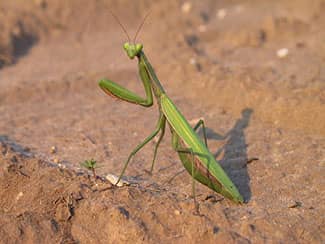
One problem with ladybugs: They will leave yards after a few weeks or months. Presumably the pests are gone and there is nothing left to eat. Some people say they leave in the summer to head for cooler mountain air. Mantises are more likely to stay around but will only live a year or so.
What about bees? Some kinds are desirable, but not all of them.
Many of us have heard a lot about Africanized honey bees and don’t want them nesting in or around our houses because they can be aggressive and cause serious injuries to humans or animals. Thousands of species of bees, however, like leaf-cutter bees, digger bees, sweat bees, and bumble bees, generally do not pose a danger and can benefit our yards, according to Professor Gouge of UA.
All wild honey bees in Arizona have been Africanized to some extent, she said. Generally, Africanized bees are found in all the southern area continental states. These honey bees can be tough to live with.
“Colonies become defensive once they have a brood (baby bees) and can pose a hazard to humans if they are in close proximity,” Dr. Gouge said. “If the colony is remote from human traffic, then I support a live and let-live approach.”
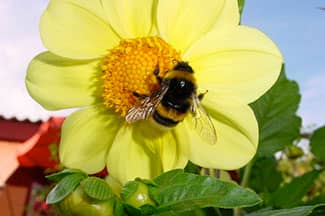
The Cooperative Extension said that swarming or foraging wild honey bees will usually chase humans or animals only if provoked or disturbed. If the worst happens though — and bees are buzzing around your head — put your hands over your face and look through gaps between your fingers while walking briskly away. Do not swat at the bees. If you are stung, cover your head and face with clothing and run to a building or shelter and go inside.
The Cooperative Extension web site advises that when pursued by bees outside “run at least 240 yards (the length of two football fields) or until the bees abandon you. Do not dive into a pool or river, the bees will wait for you longer than you can hold your breath.”
Homeowners can discourage and remove Africanized bees or wasps.

General cleaning of clutter in the yard can help discourage bees from nesting. Eliminate attractive-looking nest sites in trees by filling holes with sand or using mesh screen to block the space. Fill up holes in the soil. Don’t try to fill in areas where bees are already buzzing in and out or the bees could start attacking.
Use silicone sealant to fill cracks or holes in walls, on the roof and around foundations of a home. Ensure that window and door frames fit tightly. If bees are using water sources in the yard, like bird baths, remove them. Bees can also be attracted to swimming pools so be cautious about them as you swim.
If a nest should develop on the roof, on a wall, or in a tree, call in an expert at bee management who will relocate them or remove them for a fee. Pest control companies will dispose of them as well.
In any case, removing the danger is essential and should be done soon. Bees in the attic are a bad idea.
###
Photo Credits:

